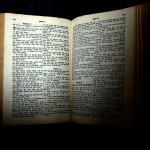A guest post from from friend-of-the-blog Silence Dogood.
The recently announced changes in CES curriculum represent something much more than what is taught at BYU campuses, institutes, and seminaries. Rather, it is an embodiment of a particular strain of scriptural interpretation that plays a central role in the modern Church.
One could argue that Mormonism was founded upon the question of scriptural interpretation. Joseph Smith, upset that the many religions of his day “understood the same passages of scripture so differently as to destroy all confidence in settling the question by an appeal to the Bible” (JSH 1:12), came to see direct revelation as the only escape from a circular hermeneutical crisis. Such was the birth of the LDS tradition’s emphasis on continuing revelation, but it also inaugurated different—and perhaps, competing—trajectories of scriptural interpretation.
On the one hand, this celebration of an open canon and line-upon-line inspiration have led some to emphasize the human nature of revelation and the potential for later revision. Terryl Givens’s recent book on the foundations of Mormon thought highlighted the various trajectories, innovations, and, at times, even dead-ends in Mormon speculative theology. This discourse has often turned to the history of Mormonism’s discarded beliefs, like the pre-1978 racial restriction, as evidence for this messy process. In this light, the act of contextualizing scripture is all the more important, because it is acknowledged that revelations and proclamations are often grounded in a cultural context that is necessary to unpack in order to glean the true meaning.
But modern leaders seem to be taking the idea of modern revelation in a different direction. Rather than raising difficult issues of infallibility, it is used to solidify contemporary authority and interpretation. The emphasis is not placed on the messy process of continuing revelation and the promise of future correction, but on the fallibility of the past and the importance of the present. Not only do ancient scripture fail to claim as much authority as modern pronouncements, but previous interpretations do not hold as much relevance as contemporary appropriation. This is most poignantly seen in Ezra Taft Benson’s famous “Fourteen Fundamentals in Following the Prophet,” where he proclaimed that the living prophet is “more vital to us than the standard works” and “more important to us than a dead prophet.” Rather than challenging the idea of infallibility, this particular framing of continuing revelation makes it nearly unavoidable.
It is important to note that this change is just one part of a much broader movement that has been in motion for some time. First, the Priesthood/Relief Society Teachings of the Presidents of the Church manuals embodied the flagrant de-contextualized inclusion of quotes from myriads of discourses across decades but framed in a way that made them seem consistent and part of a larger doctrinal whole. Then the Sunday School manuals became more thematic than chronological/contextual, which will apparently become even more common in future curriculum revisions. Even the recent Daughters in My Kingdom volume demonstrates this approach. The assumption behind much of this organization apparatus is that the canon of truth is consistent and self-referential, the language and doctrine unvarying, and that gospel truths are best understood in a doctrine.
It is easy to see why such an approach is tempting. For one thing, it keeps the gospel simple at a time when leaders seam increasingly eager to package the Church’s in a message for first-generation converts in the southern hemisphere. It is also a way to appropriate modern notions of enlightened reason so as to validate conceptions of fundamentalist interpretive authority, an act that places Mormon leaders in the same tradition as many Evangelical leaders in the twentieth century (see here and here). By more firmly establishing the boundaries of truth within an ecclesiastical tree, the problems of secular contestations are seemingly diminished.
Yet as any religious scholar will tell you, the very act of organizing ideas into a systematic system is a theological project in and of itself. Choosing what goes in, what is left out, and what message serves as the overriding message is a hermeneutical project of meaning-making just as much as were the original pronouncements being compiled. Just because they are presented without a listed “editor” or “author,” and thus under the auspices of the institutional Church, does not mean that these volumes are objective compendiums of Mormonism’s belief. But set aside the crucial issue of how this approach minimizes the dynamic and evolving notion of scriptural texts and the significance of contextual background for determining original meanings, another crucial message here is the implied notion of centralized authority behind these interpretive compilations.
In an important way, this curriculum shift is further proof that Mormonism is a priestly, not a scriptural, religion, meaning that authority is found in those wearing the mantle of authority rather than those found in the scriptural text. Instead of the notion of continued revelation destabilizing contemporary authority through the prospect of possible fallibility and future revision—an impulse mostly found in a liberal periphery of the LDS tradition—the concept has actually been interpreted in a way that solidifies the very concept of contemporary authority. Read through this particular hermeneutical vein, Mormonism’s open canon centralizes authority not in the scriptural texts but the bodies of current leaders: it is not so much important what the scriptures say, but what current Church leaders tell us those scriptures mean, and how those fungible texts can serve as springboards or creative evidence for modern arguments. It is the classic problem of originalism magnified through prophetic authority. Ancient prophetic texts act as malleable clay with which modern General Authorities construct their contemporary message.
Put simply, the hermeneutic of modern-day prophets has taken the classic Protestant issue of scriptural infallibility and the multiplicity of interpretation and turned it on its head: it has destabilized past scripture and solidified modern appropriation.
What is yet to be determined is how this approach will be received by the youngest generation of saints, especially in an age of digital information at their fingertips. Most poignantly, this approach seems to be going against other impulses found in the LDS Church History Library’s work from the last decade, including the findings of the Joseph Smith Papers Project, their incorporation of these ideas into the new scriptural headings, and even the recent topical essays; all of this work sought to problematize the notion of scriptural inerrancy and highlight the messiness of leadership and revelation. A house divided, indeed.
These two approaches embody the two possible trajectories of Mormonism’s hermeneutical tradition, even as they coexist simultaneously and uneasily at 50 East North Temple Street, Salt Lake City, and fight for the soul of LDS scriptural interpretation.











